TOPIC: UPSIDE DOWN IN AN AIRPLANE? NOW WHAT?
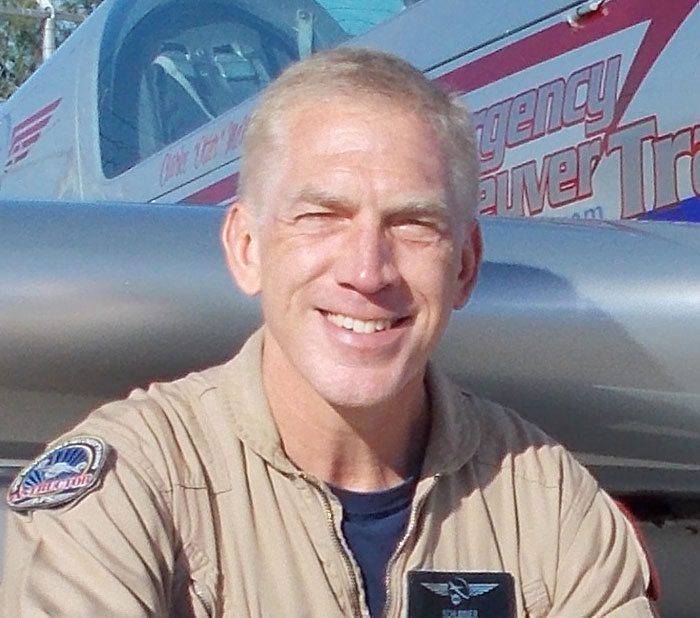 Written by: Karl “Schlimmer” Schlimm
Written by: Karl “Schlimmer” Schlimm
APS Emergency Maneuver Training
CFI, ATP – Multi IFR, IAC, ICAS
FAA – Aviation Safety Counselor
Former USAF F-16 Fighter Pilot & Instructor
“The integration of aerobatic training concepts and carefully selected aerobatic maneuvers at flight schools providing upset recovery flight courses are critical to the development of a properly aware and self-reliant pilot graduate. Aerobatics schools presenting programs titling them “upset recovery”, “unusual attitude awareness” or “emergency maneuver training” must properly focus aerobatics instruction on the aspects of each aerobatic maneuver pertinent to the development of hands-on all-attitude recovery skills in real-life upset scenarios”.
Paul “BJ” Ransbury, Master CFI-Aerobatic
Have you ever been upside down in an airplane? There are those of us who intentionally fly aerobatic-type maneuvers for fun, profit, fulfillment of the competitive spirit, and even to defend our country. As an instructor teaching emergency maneuver, unusual attitude and aerobatic training to other pilots, I see the benefits of such training daily. While a thorough emergency maneuver training course will include much more than the basic aerobatic maneuvers, aerobatic training alone is extremely beneficial. You may have no specific desire to perform a precise loop or hammerhead, but no matter what you fly or for what reason, aerobatic training, in addition to being exhilarating, can make you a safer pilot. You will also fly with increased confidence, because that “vast” unknown – flight at the “edges of the envelope” (whether intentional or not) will not be so vast or unknown anymore. According to Patty Wagstaff, three-time US National Aerobatic Champion, Air Show Performer and Author of Fire and Air: A Life on the Edge: “More and more airlines and flight departments have recognized that only a small proportion of pilots have had aerobatic training, and have become aware that putting pilots into serious unusual attitudes is one of the best ways to make sure a pilot can successfully recover when the airplane gets rolled upside down”.
Before I move on to the specific benefits of aerobatic training, let me emphasize that all airplanes, from a Boeing 777 to an F-16, to a Cessna 150 are essentially “all-attitude” machines. That doesn’t mean that it’s smart to intentionally perform aerobatic maneuvers in a non-aerobatic certified aircraft, but any airplane can end up upside down, or vertical, or anywhere in between. You may not have a choice in the matter, either. Whether due to wake- or other turbulence, wind shear, pilot distraction, flight into IMC or other conditions beyond a pilot’s experience level, mechanical failure, or some other cause, you may find yourself and your airplane in an unusual attitude. Airliners and other aircraft with pitch and bank limiters are not necessarily an exception. The first time an unusual attitude situation happens, perhaps with a load of passengers on board or low to the ground, should not be your first exposure to “aerobatic” flight. The margin for error in a non-aerobatic aircraft is small. According to Master Aerobatic Instructor Rich Stowell, author of Emergency Maneuver Training; Controlling Your Airplane During a Crisis: “Nowhere are knowledge and skill more important than during an in-flight crisis; sadly, nowhere are weaknesses in these areas more evident, either.” So let’s look at what aerobatic training can offer you:
Knowledge: Any good aerobatic course will include a discussion of the physiological effects of aerobatic flying, and the aerodynamics involved. I can’t over-emphasize the importance of a fundamental understanding of aerodynamics specifically pertaining to turning flight (and a loop is a turn!), angle of attack, stalls, and spins, as well as a good understanding of aircraft performance, structural limits, V-speeds, and what they all mean. Below is a velocity versus G-loading (V-G) diagram or as the test pilots call it, the “performance envelope” of the aircraft
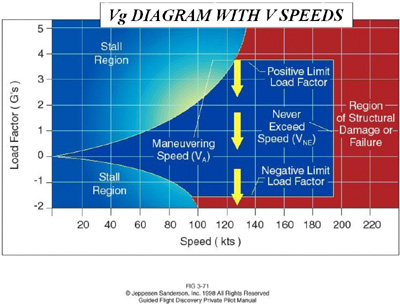
Figure 1. V-G Diagram
The airplane will stall if you attempt flight outside of the curved portions of the envelope (known as the aerodynamic or lift limits), and it may bend or break if you attempt flight beyond the straight portions (known as the structural limit defined by limiting positive and negative load factor, and by the never exceed speed, or VNE) You must also be aware of limitations associated with “asymmetric” G loading (the structural limits depicted on a typical V-G diagram or published in the Pilot’s Operating Handbook apply to symmetrical G loadings only). Asymmetric G loads occur when you are rolling and pulling at the same time. For instance, if, while recovering from a graveyard spiral, you roll upright but simultaneously pull to the limiting load factor of the aircraft, you could actually exceed the structural limit of certain parts of the aircraft, such as the root of the wing with the downward deflected aileron. You can be an outstanding aerobatic pilot, but if you don’t understand aircraft performance and associated limitations, or the dynamics of a spin, then someday your luck may run out. Conversely, all the “book” knowledge in the world will be useless, if you don’t get out of your comfort zone, seek quality aerobatic training, and start building the motor skills and kinesthetic feel necessary to fly a properly certified aircraft in all flight attitudes. Unusual attitude training in an aircraft-specific simulator has value, but this environment cannot duplicate the physiological effects of aerobatic flight, nor can one develop a kinesthetic feel for aerobatic maneuvers or unusual attitude recoveries in a simulator. Training must still be accomplished in the air.
Confidence: There is no substitute for being able to say “I’ve been there, done that.” If you have never been upside down, or in some other unusual attitude, you have no idea what your reaction will actually be. Typically, the “intuitive” recovery response will not promote minimal altitude loss and airframe structural integrity. Lack of confidence and training promotes panic, which will lead to hesitation and inappropriate control inputs. Such responses can lead to structural failure or ground impact.
Motor Skills: No amount of knowledge can replace the motor skills necessary to roll an airplane smoothly upright whether to perform a good aileron roll, or for survival following an aircraft “upset.” A pilot does not have to be an outstanding aerobatic pilot to recover an aircraft from a wake turbulence encounter with minimum altitude loss. However, I am convinced that an aerobatic pilot will, if faced with a similar unusual attitude, be able to apply aerobatic skills to the situation, and recover much more effectively than a pilot who has not been exposed to such training. For instance, even a pilot performing his or her first aileron roll in a controlled environment, and after a thorough briefing, will most likely commit such errors as pulling back on the stick or yoke while rolling, or hesitating or stopping the roll approaching inverted. Any one of these mistakes, if faced with an unusual attitude, will decrease the chances of a successful recovery in a critical situation. To build the motor skills to perform a proper aileron roll, as in any other aerobatic maneuver, takes much practice and repetition. In fact, in the majority of instances, a pilot without aerobatic or emergency maneuver training will “pull through” into a Split-S type maneuver when faced with an inverted unusual attitude. That is 100% incorrect and possibly deadly. According to Rich Stowell, “…the better prepared we are for a crisis, the higher the probability that we’ll act instinctively to correct it. Physically practicing procedures for various scenarios develops a kinesthetic memory…that can give you a critical edge in an emergency.”
Maintaining Orientation: In low visibility conditions, or in IMC, a pilot must rely on the instruments to maintain orientation. In VMC, the horizon is available to assist in orientation, and is the only completely reliable “attitude indicator.” Yet pilots who have not received aerobatic training typically do not know where to look to find the horizon when in an extreme unusual attitude. When in an over-banked unusual attitude, it is important to quickly find the nearest horizon in order to roll in the shortest direction to upright, and especially to avoid pulling the nose down through the vertical and back up to the horizon which will, in most cases, result in excessive altitude loss. Yet in my experience as an aerobatic instructor, I have found many cases where, when performing one’s first aileron roll, the student forgets to even look outside the cockpit! Visual cues (if available) are an invaluable tool, because, as any instrument pilot can tell you, your vestibular system (your “inner ear”) can, and will lie to you, whereas your eyes will tell your brain the “real” story. For instance, on recovery from a spin or spiral dive, your inner ear will tell you that you are still spinning or rotating (that “dizzy” feeling), but your eyes will tell you (upon looking at the horizon, or if that’s not available, looking at the instruments) that you have recovered.
Kinesthetic Feel: You are likely aware of the limit load factor of your airplane. But do you know what 2.5 or 3.8 G’s feels like? You have probably experienced 2 G’s in a 60-degree bank turn. Following a high speed dive recovery from an over-banked nose low attitude, with adrenaline flowing and heart pounding, it would be easy to overstress the airplane as excessive backpressure is applied. Most aircraft do not have G meters installed. Aerobatic training can provide you with the kinesthetic (‘seat-of-the-pants”) feel for different G loads. But more than that, aerobatic training can make you more aware of the feeling when the aircraft is in coordinated flight, and when it is not. Also, you learn to feel when the airplane is approaching the stall (or critical angle-of-attack) regardless of aircraft attitude or airspeed. If an aerobatics-trained pilot pulls back excessively on the yoke or stick on the backside of the loop (inverted, nose low), and the aircraft buffets and stalls, this is not a big deal anymore, because he or she knows to instinctively release a small amount of back pressure to un-stall the wings, then proceed with the remainder of the loop. When is the last time you fully stalled an airplane even upright? Were you comfortable with that situation?
Benefits of Specific Aerobatic Maneuvers: Even though aerobatics per se isn’t the focus of emergency maneuver and upset training, a number of standard aerobatic maneuvers are taught for their high educational value. Below I’ve listed just a few of the unique benefits of specific aerobatic maneuvers.
Aileron Roll: After pulling the nose up approximately 30 degrees above the horizon, you learn to neutralize pitch (elevator) by “checking” the stick or yoke before rolling, so that you don’t inadvertently pull aft during the roll. Two detrimental actions typically result when the pilot fails to check the stick: first, the pilot does not apply all of the aileron available to correct the over-banked attitude; second, any pulling on the elevator subjects the airplane to unnecessary G-loads and drags the nose down below the horizon even farther. You also learn how to keep the horizon in view while rolling or over-banked.
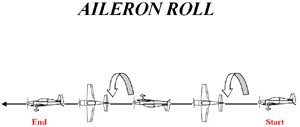
Loop: A loop teaches you the following: to fly the airplane effectively at extreme pitch attitudes, and to remain below critical angle of attack; to disassociate angle of attack with pitch attitude (you can stall the aircraft in any conceivable attitude); to be able to find the horizon while in any pitch attitude. For instance, at the beginning of the loop, the pilot sees the horizon over the nose. As the loop progresses, the horizon disappears under the nose. The pilot looks left (or right) to find the horizon, until the aircraft approaches the inverted position at the top of the loop, at which point the pilot transitions his view straight back to find the horizon, then keeps it in view throughout the rest of the maneuver.

Inverted Flight: Flying inverted gives you an appreciation for the stick forces required to hold the nose up in inverted flight. Also, you develop an appreciation for how the nose will drop aggressively toward the ground while over-banked if you do not apply some forward pressure (or at least release back pressure) for the length of time that you are inverted (which hopefully would not be too long if in an unusual attitude, assuming you can find the nearest horizon and quickly initiate a roll towards it.)
Cuban Eight: After pulling to an inverted 45-degree nose low attitude from the first part of a loop, you learn to halt the downward trend by checking the nose with forward elevator pressure, and then to roll upright.
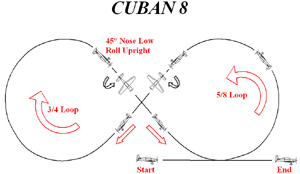
Split S: A split-S gives you an appreciation for how much altitude you would lose if you “pulled through” from an over-banked or inverted unusual attitude versus checking with forward elevator and then rolling. You also develop a feel for flying the aircraft just below critical angle of attack to minimize altitude loss in a dive recovery. Here you manage the G loading versus airspeed, increasing G’s as airspeed increases while staying below critical angle-of-attack (and the structural limits of the aircraft.).
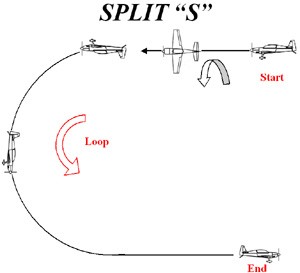
Hammerhead: A hammerhead illustrates how an aircraft flies very well below critical angle-of-attack, even at extremely low airspeed (well below the 1G stall speed) and with heavy rudder inputs. (An aircraft, for instance will not spin, even in uncoordinated flight if the wings remain below critical angle-of-attack).

Immelman or Half Loop: In both of these maneuvers, you learn how to roll from inverted to upright without losing altitude and at a very slow airspeed, just above the 1G stall speed. This could help in recovering from an over-banked unusual attitude on final approach (a wake turbulence encounter for instance).

Other Benefits of aerobatic training: In the course of aerobatic training, you will experience many “botched,” or incorrectly flown maneuvers. You will learn to “finesse” an airplane out of an accelerated stall in the second quarter of a loop, or to control an incipient spin entry while rolling upright at the top of an Immelman. When faced with a high-speed, over-banked nose low unusual attitude, you will learn to reduce power, “check” the nose, find the nearest horizon and roll to it, then recover smoothly to the horizon. Botched maneuver recoveries should actually be a planned part of a good all-attitude training program. These situations can develop quickly, and you will learn to recognize and avoid potential unusual attitudes with correct and smooth control responses with little effort. The advantage of an emergency maneuver training course over a true basic aerobatic course is that more “real world” unusual attitude scenarios are incorporated, with more emphasis on how the procedures taught apply to your aircraft and your environment. And, versus an emphasis on precision aerobatic maneuvering, emergency maneuver training emphasizes recognition, avoidance, and if an unusual attitude develops, correct recovery procedures that apply to the entire spectrum of aircraft. While an aerobatic-specific course teaches you to perform within the limits of the aerobatic aircraft, a well-designed emergency maneuver training course will teach you how to recover within the limits of the aircraft that you actually fly.
Can aerobatic training benefit you? If you have never been upside down in an airplane, are nervous of stalls, or are afraid of spins, then you would definitely benefit from aerobatic training alone, or as part of an emergency maneuver or unusual attitude training course. No other training can duplicate the physiological effects of flight in all attitudes, nor can provide the advantages of repetitive exercises to reinforce proper recovery procedures. This type of training will not only make you a safer pilot, but also a more confidant pilot!
Closing Comments and Recommendations:
What is your best defense in aircraft unusual attitude or upset conditions?
- First, attempt to avoid conditions that can induce unusual attitudes in the first place! Steer clear of thunderstorms and wake turbulence! Avoid IMC or flight into low visibility conditions if not properly certificated and trained. Avoid distractions.
- Second, get the proper training. According to an article in AW&ST (May 8, 1995 issue): “Training should include flights in aerobatic aircraft to practice recovery techniques because no simulator can model the disorientation of actually being upside down… recurrent training every two years, with time in an actual aircraft, would be a good start.” Regardless of the aircraft that you fly, proper training will enable you to learn to react decisively in a high-pressure environment, and to learn proper recovery techniques to avoid a “panic” response that could worsen the situation.
- Contact a APS Training representative. Certainly, we would like to take this opportunity to recommend our program at APS which offers three course layouts to choose from. Please give us a call a 1-866-359-4273 and ask to speak with a flight training specialist or submit the online form below for more information today!
Get this training somewhere. The life you save may be more than just your own.




Thanks for helping me learn more about aerobatics training. I actually didn’t know that an aerobatic course can actually go over some physiological effects of this kind of flying. You mentioned that the physiological effects can only really be trained and done in the air. I hope that there is a way for this to be able to be simulated in VR in the future, especially if it can be done well enough that it can benefit the pilot.